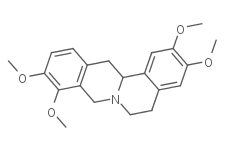
Rotundine b
CAS No. 483-14-7
Rotundine b( L-Tetrahydropalmatine | (-)-Tetrahydropalmatine | Caseanine | Gindarine )
Catalog No. M19458 CAS No. 483-14-7
Rotundine (L-tetrahydropalmatine L-THP) is a selective dopamine D1 receptor antagonist with IC50 of 166 nM.
Purity : >98% (HPLC)
 COA
COA
 Datasheet
Datasheet
 HNMR
HNMR
 HPLC
HPLC
 MSDS
MSDS
 Handing Instructions
Handing Instructions
| Size | Price / USD | Stock | Quantity |
| 50MG | 47 | Get Quote |


|
| 100MG | 68 | Get Quote |


|
| 500MG | 165 | Get Quote |


|
| 1G | Get Quote | Get Quote |


|
Biological Information
-
Product NameRotundine b
-
NoteResearch use only, not for human use.
-
Brief DescriptionRotundine (L-tetrahydropalmatine L-THP) is a selective dopamine D1 receptor antagonist with IC50 of 166 nM.
-
DescriptionRotundine (L-tetrahydropalmatine L-THP) is a selective dopamine D1 receptor antagonist with IC50 of 166 nM.(In Vivo):It is reported that Rotundine (l-THP) possesses a blocking effect on dopamine D1 and D2 receptors and can inhibit physical dependence in morphine dependent mice and significantly reduce the development of the conditional place preference induced by morphine in mice. On day 1 and 7, there is no difference in locomotor counts between the Rotundine groups (6.25, 12.5, and 18.75 mg/kg) and saline group [F(3, 37)=1.360, P>0.05, F(3, 37)=0.348, P>0.05, respectively]. Locomotor counts are greatly increased in the oxycodone group compare with the saline group. Rotundine at doses of 6.25, 12.5, and 18.75 mg/kg antagonizes hyperactivity induced by oxycodone [F(4, 60)=15.76, P<0.01]. Rotundine (6.25, 12.5 mg/kg) does not affect the magnitude of sensitization, but there is a marked difference between oxycodone+oxycodone group and Rotundine (18.75 mg/kg)+oxycodone+oxycodone group, indicating that Rotundine (18.75 mg/kg) greatly inhibits the development of oxycodone sensitization [F(4, 62)=8.766, P<0.01].
-
In Vitro——
-
In VivoIt is reported that Rotundine (l-THP) possesses a blocking effect on dopamine D1 and D2 receptors and can inhibit physical dependence in morphine dependent mice and significantly reduce the development of the conditional place preference induced by morphine in mice. On day 1 and 7, there is no difference in locomotor counts between the Rotundine groups (6.25, 12.5, and 18.75 mg/kg) and saline group [F(3, 37)=1.360, P>0.05, F(3, 37)=0.348, P>0.05, respectively]. Locomotor counts are greatly increased in the oxycodone group compare with the saline group. Rotundine at doses of 6.25, 12.5, and 18.75 mg/kg antagonizes hyperactivity induced by oxycodone [F(4, 60)=15.76, P<0.01]. Rotundine (6.25, 12.5 mg/kg) does not affect the magnitude of sensitization, but there is a marked difference between oxycodone+oxycodone group and Rotundine (18.75 mg/kg)+oxycodone+oxycodone group, indicating that Rotundine (18.75 mg/kg) greatly inhibits the development of oxycodone sensitization [F(4, 62)=8.766, P<0.01].
-
SynonymsL-Tetrahydropalmatine | (-)-Tetrahydropalmatine | Caseanine | Gindarine
-
PathwayGPCR/G Protein
-
TargetDopamine Receptor
-
RecptorD1 receptor 5-HT1A D2 receptor D3 receptor
-
Research Area——
-
Indication——
Chemical Information
-
CAS Number483-14-7
-
Formula Weight355.43
-
Molecular FormulaC21H25NO4
-
Purity>98% (HPLC)
-
SolubilityDMSO:8 mg/mL (22.5 mM);Ethanol:<1 mg/mL;Water:<1 mg/mL
-
SMILES[H][C@@]12CC3=CC=C(OC)C(OC)=C3CN1CCC1=C2C=C(OC)C(OC)=C1
-
Chemical Name——
Shipping & Storage Information
-
Storage(-20℃)
-
ShippingWith Ice Pack
-
Stability≥ 2 years
Reference
1.Wang JB et al. Future Med Chem 2012 4(2) 177-186.
molnova catalog



related products
-
CCT241736
CCT241736 is an orally bioavailable dual FLT3/Aurora kinase inhibitor that also inhibits clinically relevant FLT3-resistant mutants including FLT3-ITD and FLT3.
-
Tedatioxetine
Tedatioxetine (Lu AA24530) is a serotonin-norepinephrine-dopamine reuptake inhibitor (SNDRI) with antidepressant properties.Tedatioxetine acts as a CYP2D6 substrate.
-
NMI 8739
NMI 8739 is an agonist of D2 autoreceptor. NMI 8739 reduces NO production and elicits concentration-dependent suppression of CCL-20, MCP-1 and IL-6 release.



 Cart
Cart
 sales@molnova.com
sales@molnova.com


